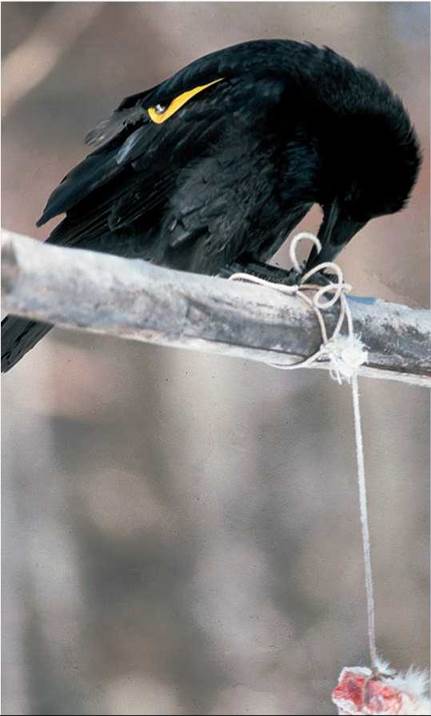THE LIVING WORLD
Unit Eight. The Living Environment
37. Behavior and the Environment
37.6. Animal Cognition
For many decades, students of animal behavior flatly rejected the notion that nonhuman animals can think. Instead, the prevailing approach was to treat animals as though they responded to the environment through instinct and simple innately programmed learning.
In recent years, serious attention has been given by researchers to the topic of animal awareness. The central question is whether animals other than humans show cognitive behavior—that is, do they process information and respond in a manner that suggests thinking?
Evidence of Conscious Planning
What kinds of behavior would demonstrate cognition? Some birds in urban areas remove the foil caps from nonhomog- enized milk bottles to get at the cream beneath. Japanese macaques (a kind of monkey) learn to float grain on water to separate it from sand, and teach other macaques to do it. A chimpanzee pulls the leaves off of a tree branch and uses the stick to probe the entrance to a termite nest and gather termites, suggesting that the ape is consciously planning ahead, with full knowledge of what it intends to do. A sea otter will use a rock as an “anvil,” against which it bashes a clam to break it open, often keeping a favorite rock for a long time, as though it had a clear idea of its future use of the rock.
Problem Solving
Some instances of problem solving by animals are hard to explain in any other way than as a result of some sort of cognitive process—of what, if we were doing it, we would call reasoning. For example, in a series of classic experiments conducted in the 1920s, a chimpanzee was left in a room with a banana hanging from the ceiling out of reach. Also in the room were several boxes, each lying on the floor. After unsuccessful attempts to jump up and grab the banana, the chimpanzee suddenly looked at the boxes and immediately proceeded to move them underneath the banana, placing one on top of another, and climbed up the boxes to claim its prize. Many humans would not have solved the problem so quickly.
It is not surprising to find obvious intelligence in animals so closely related to us as chimpanzees. Perhaps more surprising, however, are recent studies finding that other animals also show evidence of cognition. Ravens have always been considered among the most intelligent of birds. Bernd Heinrich of the University of Vermont conducted an experiment using a group of hand-reared ravens that lived in an outdoor aviary. Heinrich placed a piece of meat on the end of a string and hung it from a branch in the aviary. The birds like to eat meat, but had never seen string before and were unable to get at the meat. After several hours, during which time the birds periodically looked at the meat but did nothing else, one bird flew to the branch, reached down, grabbed the string with its beak, pulled it up, and placed it under his foot. He then reached down and pulled up another length of the string, repeating this action over and over, each time bringing the meat closer (figure 37.6). Eventually the meat was within reach, and was grasped and eaten by the bird. The raven, presented with a completely novel problem, had devised a solution. Eventually, three of the other five ravens also figured out how to get the meat. This result can leave little doubt that ravens have advanced cognitive abilities.

Figure 37.6. Problem solving by a raven.
Confronted with a problem it had never previously encountered, the raven figures out how to get the meat at the end of the string by repeatedly pulling up a bit of string and stepping on it.
Key Learning Outcome 37.6. Research on the cognitive abilities of animals is in its infancy, but some examples argue compellingly that animals can reason.